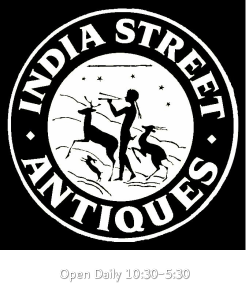Chairs and Seating
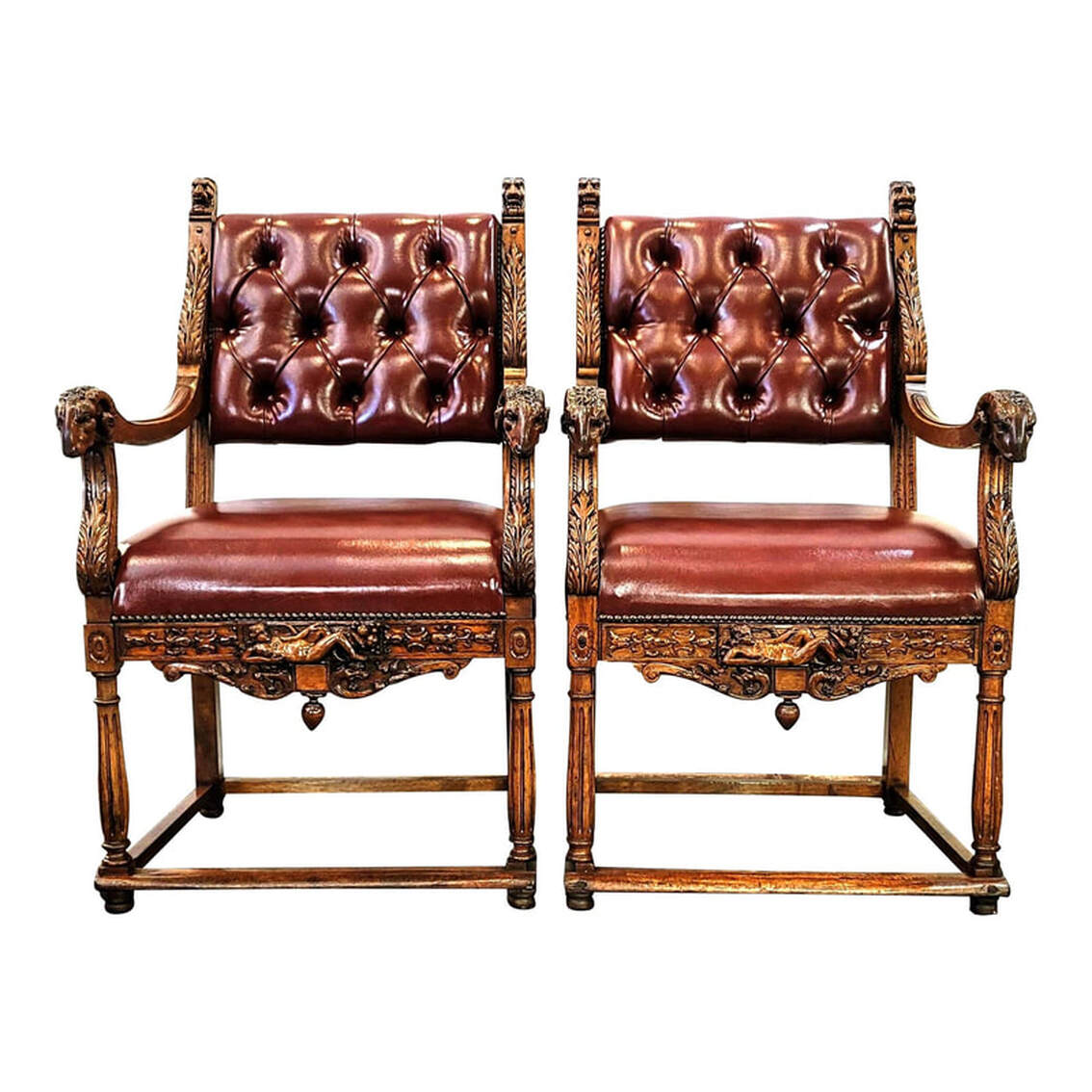
Pair Carved Armchairs | Renaissance Revival | France | circa 1900
Pair late-19th-century through 1910 walnut French Renaissance Revival armchairs feature carvings of acanthus leaves, lion head finials, ram's heads at the ends of the arms, a nude reclining Demeter with cornucopia at the center of the front seat rails, and stylized scrolling dragons on the front aprons.
The backs and seats are upholstered in leather-like burgundy fabric with button tufting on the backrests.
Four low stretchers connect the legs above padded feet.
These were purchased from a sale at The Royal Palladium London Theatre.
SIZE:
25" wide x 27" deep x 42.5" high
Seat Height = 20"
Seat to top of Backrest = 20"
Interior seat depth = 19"
Interior seat width = 20"
Arm rest height = 6"
Click on the photo for further information and to view more photos.
5399
SOLD
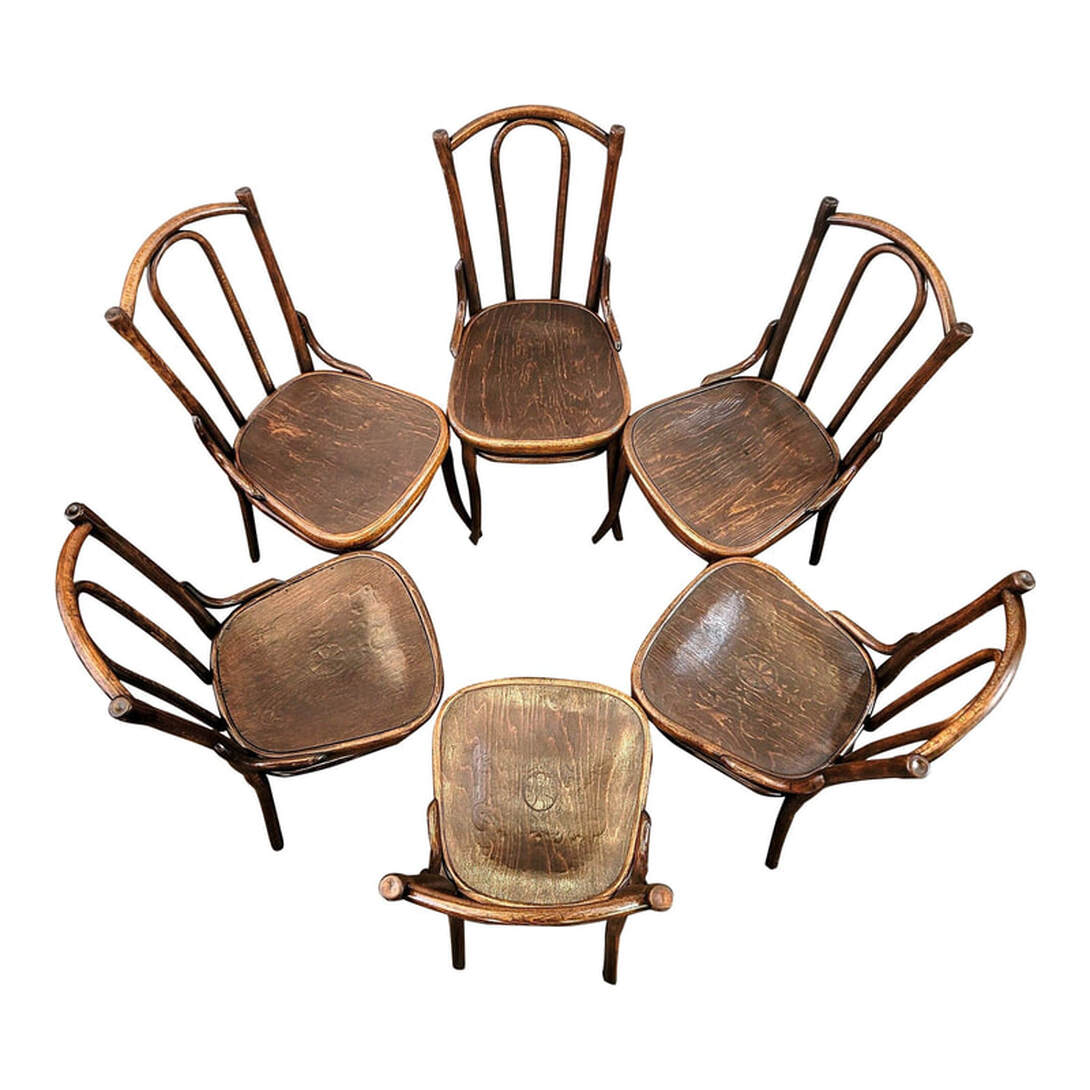
SOLD
Set of Six Bentwood Number 118a Sessel Cafe Chairs | Gebrüder Thonet | c.1906
Set of six Michael Thonet beech bentwood number 118a Sessel chairs.
The Thonet number 118a chair was a designed as a pressed pattern inset triangular wood seat variation of the number 56 chair design with caned seat. The number 56 debuted in the 1886 Gebrüder Thonet catalog and the pressed seat variation 118a may be seen in the 1906 catalog.
The chairs are stamped "THONET" and the labels indicate they were manufactured in Gebrüder Thonet's Budapest, Hungary factory.
2695
Click on the photo above to learn more and to view further photos.

Set of Four Antique Rosewood Chairs Attr. to Gillows of Lancaster
1821-1839
18.5ʺW × 21ʺD × 33ʺH
3699 / SET
Set of four waisted open balloon back chairs numbered III, V, VIIII, and X, indicating these were once part of a set of 10 to 20 chairs.
Gillow & Co. created large chair sets for their upscale clients in Lancaster.
The style of the chairs is inspired by both the hot air balloon flight of the Montgolfier brothers in 1783, which led to the creation of a "Montgolfier" or "balloon back" chair design, and Grecian design elements, as can be seen here by the addition of volutes (scrolls) to the top rails.
The seats were originally hand-caned. The remnants of this process may be seen under the upholstered drop-in seats, which represent the later trend of adding fabric covered seats over, or in place of, caned seats on this style of chair.
See matching Gillows table below.
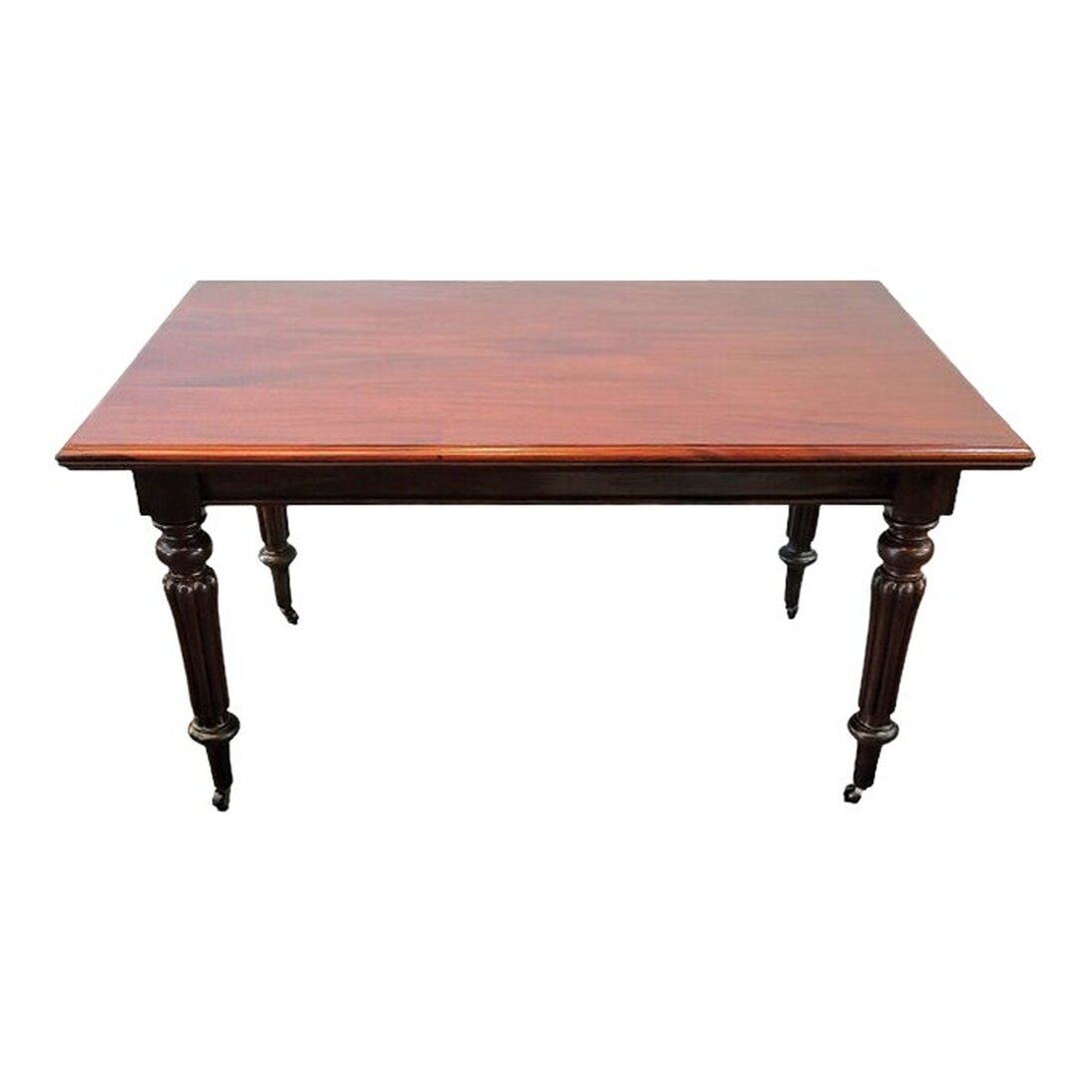
Architectural and interior drawings executed in the early 19th century and in the collection of the Victoria and Albert Museum show that Gillows created variations of this table for the upscale clients of Gillows of Lancaster & London between 1806 and 1831, placing this table in the eras of the rulers George IV, William IV, and Queen Victoria. The legs, and legs similar to, were used with frieze, top, and shelf variations for library tables, sideboards, servers, dressing tables, washstands, and pianofortes.
Click on the photo to learn more and to view further images.
SOLD
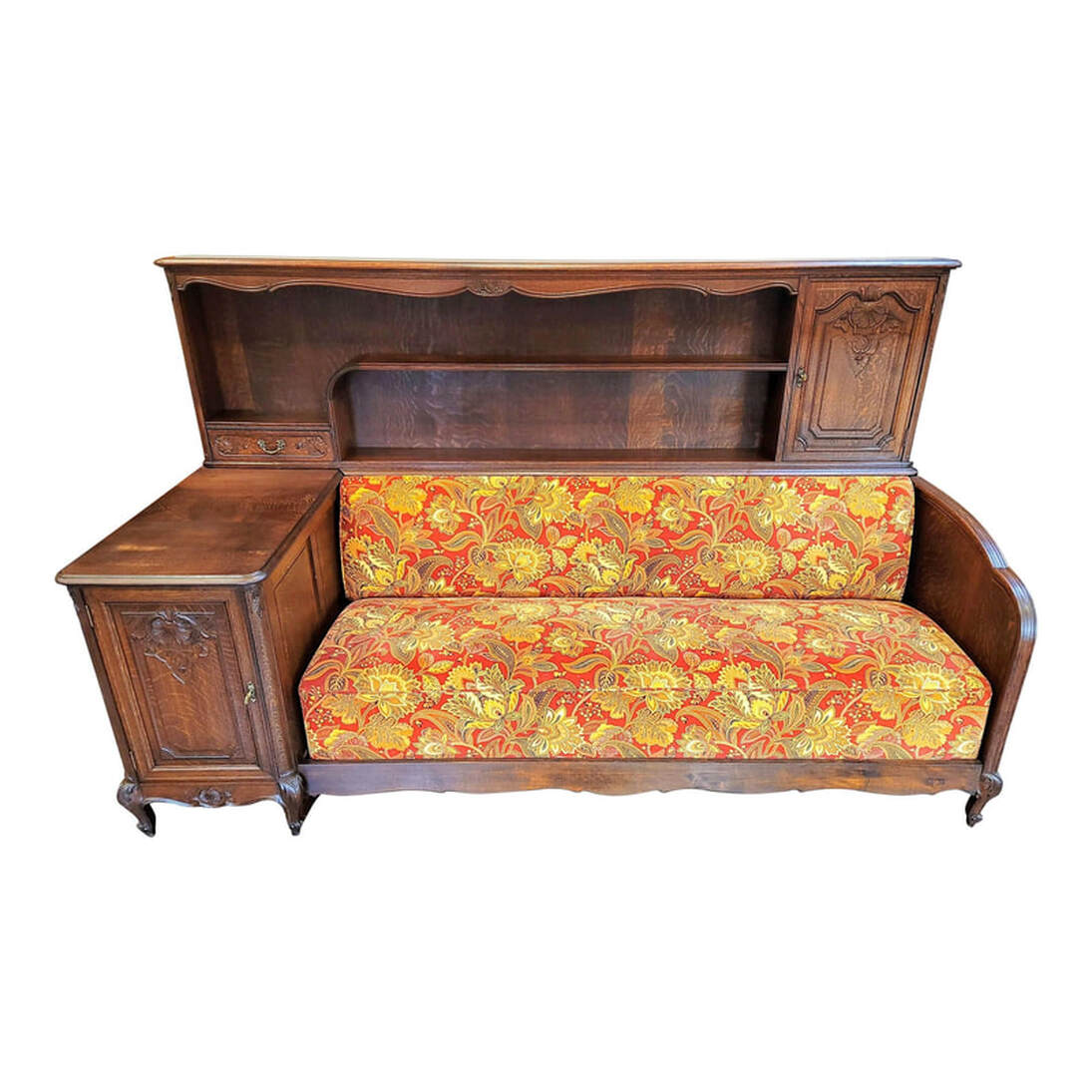
Cozy Corner | Louis XIV Style | Liège, Belgium | c. 1920
Antique Cozy Corner consists of an upholstered sofa bench, shelves, and cabinets.
Cozy Corners were designed and manufactured mainly in Belgium, France, Holland, and England from about 1898 through to the 1960s. Cozy Corners were made in many styles, including Arts & Crafts, Art Nouveau, Art Deco, and the Louis style offered here.
This Cozy Corner was made in Liège, Belgium circa 1920.
The delicate carving in the oak wood is in the Louis XV Regency style of Liège, Belgium. The refined foliate flourishes, gentle curves, and naturalistic floral and shell motifs are influenced by the Rococo and resemble French wall paneling. These are hallmarks of Liège style ornamentation and carving on furniture.
The firm spring sofa is nicely upholstered in a hardy velveteen fabric with a red ground on which are printed leaves and flowers in fall colors of yellows, golds, browns, grays, black, and tans.
The sofa is surrounded by quarter-sawn, or "tiger" oak built-ins.
The flat top has a curved apron carved at center with bell flowers.
Below top is a curved shelf at right of which is a cabinet containing one shelf and at left of which is one storage drawer.
The right side of the sofa is enclosed with a curved tiger oak panel with stunning golden rays in the figure of the wood.
The left side of the sofa has generously sized cabinetry. One cabinet is accessible from the front, the other at the side.
The upper and lower front cabinets have carved doors.
The left side cabinet door is plain.
The two bottom cabinets each have one adjustable shelf and cleats are included.
The cabinet doors lock and the piece does come with keys. The key escutcheons are figural brass grotesques.
The curved stiles are carved with bell flower pendants.
The curved sofa aprons cover the front and sides.
The piece stands on carved and scrolled cabriole feet.
The back is constructed of paneled oak wood.
The Cozy Corner breaks down into six pieces for transport.
Click on the image above to view more photos and to learn more.
95ʺW × 41.5ʺD × 57ʺH
00
SOLD
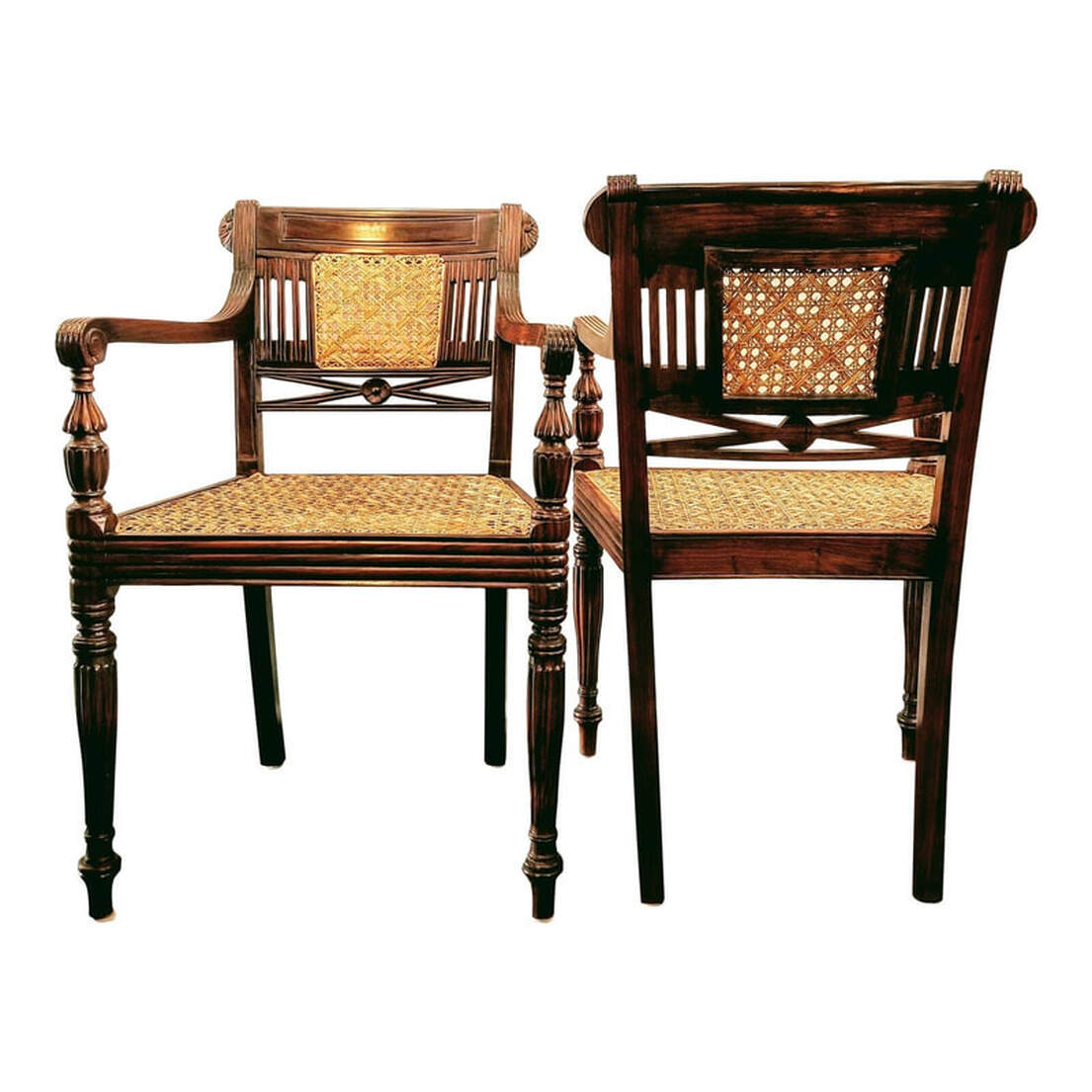
Pair Hand-Caned and Carved Reclaimed Burma Teak Dining Armchairs | The "Moore" Dining Armchairs | The Raj Company | Mumbai, India | 1990s
Raffles type dining armchairs or side chairs were hand crafted by The Raj Company in Mumbai, India in the 1990s.
These are called the "Moore" chair and were created to accompany the "Bombay" dining chairs from The Raj Company.
The Raj Company specializes in colonial and custom furniture. These chairs are rare to find on the secondary market.
The chairs are crafted from reclaimed Burma teak wood and featuring carvings in the expected patterns associated with these types of British and Dutch Colonial chairs, which are modified from the Regency and Sheraton styles: ridged grooves, turns, simple lines, and scroll ornaments.
The seats and backs are of handwoven cane. Originally, upholstered loose cushions would have been placed on top of the rattan for lounging.
The top rails are carved at center with a rectangular design suggesting cock-beading and extend past the stiles with relief-carved foliated ears.
Below the upper and lower rails are fluted spindles on either side of a canted-corner square of caning.
The lower rail features open crossed fluted spindles with a a carved flower medallion at center.
The back is gracefully curved for comfort.
The fluted arms end in a scroll.
The seat is hand caned.
The front and side seat rails are fluted.
The decorative front legs are hand carved and turned and feature melon cup-and-cover at top and turned rings above and below fluted tapers.
SIZE:
22" wide x 18" deep X 33.25" high
18" seat height
18" wide seat at front x 14" wide seat at back x 17.5" seat depth
27" floor to top of arm
9.25" seat to top of arm
1495
Click on image above to learn more and to view further photos.
SOLD

Commode Chair | Chaise Percée | Chaise Necessaire | France | 19th Century
Mid-19th-century French double caned cherry wood commode chair / chaise percée / chaise nécessaire.
This style of commode chair was in use approximately from the time of Louis XIV through the 1920s. This chair was manufactured in the mid-1800s, during the reigns of King Louis-Philippe, followed by Emperor Napoleon III over France and of Queen Victoria over Great Britain.
The chair has a caned cartouche back, a caned curved top seat, an elegantly shaped open toilet seat, iron hinges, rear stiles ending in sabre legs, curved front and side seat rails, and ringed and tapered front legs under blocks.
The chair was constructed using various joinery techniques including pegs, mortise-and-tenon, and screws.
Click on the above image to learn more and to access further photos.
19" wide x 22" deep x 38.5" high
sold
